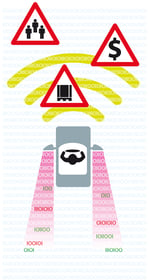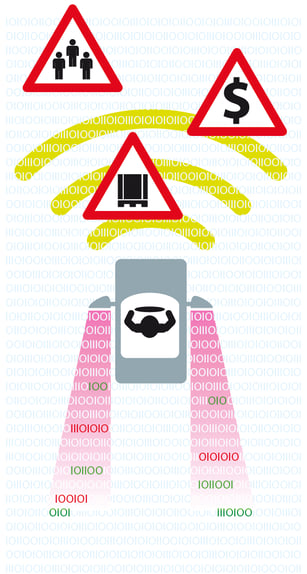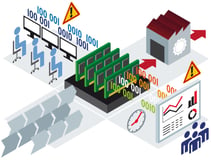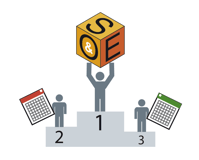Why Your Supply Chain Needs Accurate Forecasts
Brian Hoey - August 27, 2019

 One of the most common metaphors you hear for forecasting in supply chain management is that it’s like the rear-view mirror in your car: you need to understand what’s happening behind you, but it’s not necessarily enough information to keep you slamming into the car in front of you. As the supply chain has evolved, however, forecasting has evolved along with it. So, for that matter, have cars: in the modern supply chain, forecasting can encompass not just the rear-view mirror, but the back-up camera, and even the smart sensors that alert you when you’re getting too close to another car.
One of the most common metaphors you hear for forecasting in supply chain management is that it’s like the rear-view mirror in your car: you need to understand what’s happening behind you, but it’s not necessarily enough information to keep you slamming into the car in front of you. As the supply chain has evolved, however, forecasting has evolved along with it. So, for that matter, have cars: in the modern supply chain, forecasting can encompass not just the rear-view mirror, but the back-up camera, and even the smart sensors that alert you when you’re getting too close to another car.
These new processes that move beyond the scope of the rear view mirror use technology to take in additional information, and then spit out new insights for the driver to use—from immediate course-correct notifications to more granular data about when you’re going to hit the curb while parallel parking. In each case, digitization has played a big role in giving you a more comprehensive overview of events that are about to take place. In an industrial context, we might think of these digital enhancements as things like IoT (internet of things) devices and other smart sensors that provide live information to planners. In this way, forecasting becomes more thoroughly integrated into the way that businesses make decisions and optimize their supply chain management. And it’s lucky for us that it does so, because accurate forecasts are becoming more important than ever in the world of supply chain planning.
Who Does Forecasting Impact?
Okay, everyone knows that forecasting is critical, but why should it be the case that it’s more critical now than it used to be? Forecasts typically fall into one of three categories—supply, demand, and price—with each one affecting a different part of the value chain. As profit margins get thinner and thinner and the production and shipping of goods become both more exacting and more complex, each of these forecast types increasingly affects more than the traditional areas with which they’re associated. For instance, demand forecasts have historically had an outsize importance for make-to-stock manufacturers, because they want to align their supply levels with likely future demand as closely as possible (in order to avoid too much unsold stock taking up valuable warehouse space). But today, even a manufacturer working with a make-to-order mindset needs to predict demand effectively in advance in order to make sure that they have the necessary materials on hand from their suppliers when the orders do come in.
The need to mitigate long supplier lead times is, of course, not a new phenomenon. So what’s really driving this increase in the importance of forecasting? In part, it’s due to an ongoing industry-spanning push to reduce lead times at every turn—which can’t really be accomplished in a cost effective way without aligning expectations and reality. What’s driving this push to reduce lead times? Well, other a general appreciation for lean workflows, changing customer expectations are arguably among the biggest drivers of these trends. It’s important to note, however, that these changes in expectations aren’t arbitrary—rather, they change as various other players in the supply chain demonstrate what’s possible in a digital supply chain environment. Thus, as businesses on the cutting edge pioneer shorter and shorter customer delivery lead times, other businesses need to find a way to catch up.
The Data Revolution
The open question as we think about the increasingly lean face of the modern value stream, then, is this: how are businesses speeding up sourcing, order fulfillment, and shipping processes? The short answer: data. As more and more businesses ditch the spreadsheet and start managing order creation and production planning digitally, more data than ever before is made available with which planners and strategists can refine their operations. In fact, with the rise of advanced analytics and machine learning, all of the data that’s accumulated across various supply chain touchpoints can be directly leveraged into better predictions. Rather than simply relying on past events to be instructive for future market conditions, these advanced predictive algorithms make it possible to find hidden connections latent in your data that point to future trends.
In this way, you can improve the accuracy of your forecasts, and thereby power much smoother operations in a variety of ways. For a make-to-stock manufacturer, for instance, this improvement in demand forecast quality could directly lead to the reduction of unsold stock taking up expensive warehouse space. By the same token, make-to-order manufacturers could source their raw materials more effectively—and both could set their prices more effectively by tapping into the coming market trends. Thus, you’re able to go comparatively lean (by reducing buffer stock) without incurring undue risk of disruptions.
Self-driving Supply Chains
Of course, the types of forecasting improvements we’re talking about don’t just save money and make it easier to meet customer expectations—they also help to boost supply chain transparency and power the next wave of digital value chain technologies. After all, for these workflows to be effective, shippers and manufacturers need to be able to collect all of the data that’s slated to be analyzed and store it in a way that’s accessible to relevant stakeholders. In so doing, these organizations are able to prepare themselves for further digital transformation and even Logistics 4.0 workflows.
Ultimately, combined technological and operational improvements will produce a positive feedback loop, in which improved demand, supply, and price predictions enable you to operate more efficiently, and you’re able to leverage those increases in efficiency into more powerful digital analytics flows. If we think back to the car we used as an example in the first section, these increasingly digital, autonomous, and sophisticated supply chains might be more like cloud-connected cars that are able to communicate directly with other vehicles (and sensors) on the road in order to better respond to traffic patterns. Sure, the first few cars to roll out functionality like this won’t have the maximum value of the connection available to them immediately, but they’ll stand poised to take advantage of the increasing integration as other users get on board.
LATEST POSTS
- Understand Circular Economy in The Manufacturing Industry
- How Can Industry 4.0 IT Integration Be Achieved Smoothly?
- The Significance of Order Sequencing in Discrete Manufacturing
- How to improve your Supply Chain Management: The Power of Control Towers
- Optimizing Human Resource Scheduling in Manufacturing: A Technological Approach



